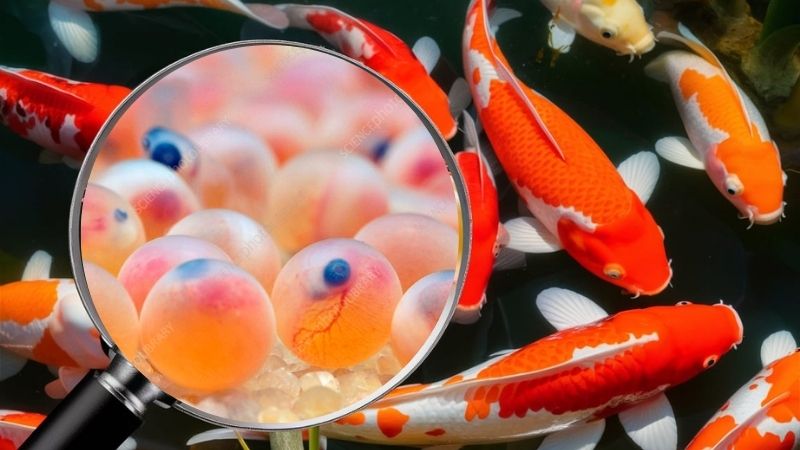Koi fish, with their vibrant colors and graceful movements, are a captivating addition to any pond or water garden. But for dedicated koi enthusiasts, the cycle of life extends beyond the beauty of adult fish, encompassing the fascinating world of koi fish eggs. Understanding what do koi fish eggs look like is crucial for successful breeding and the preservation of these captivating creatures. Let’s explore with Love My Koi!
The Mystery of Koi Fish Eggs: Unveiling the Secrets of Spawn

Koi fish, like many other fish species, are egg-laying creatures, and their eggs, known as “spawn,” are a testament to the intricate cycle of life in the aquatic world. These tiny, delicate orbs hold the potential for new life, and understanding their appearance and care is essential for successful breeding.
1. Appearance:
- Size and Shape: Koi eggs are typically small, ranging from 1-2 millimeters in diameter, and are generally spherical or slightly oval in shape.
- Color: Freshly laid koi eggs are usually translucent, with a slightly yellowish or milky hue. As they develop, they may become more opaque and take on a slightly darker color.
- Texture: Koi eggs have a smooth, gelatinous texture, similar to the consistency of jelly. This gelatinous coating helps protect the developing embryos and provides a moist environment for their growth.
2. Location:
- Nesting Sites: Koi typically lay their eggs in clusters, often attached to aquatic plants, rocks, or other submerged objects. They may also lay their eggs in shallow areas of the pond, where they are exposed to sunlight and warmer water temperatures.
3. Development:
- Incubation Period: The incubation period for koi eggs can vary depending on water temperature. In optimal conditions (around 70-75°F), the eggs may hatch in 3-5 days. However, in cooler temperatures, the incubation period can extend to 10 days or more.
- Embryonic Development: As the eggs develop, the embryos inside can be seen with the naked eye. The embryos grow larger and more defined, and their eyes become visible.
- Hatchling Stage: Once the embryos are fully developed, they hatch into tiny, free-swimming larvae known as “fry.” These fry are very vulnerable and require a suitable environment to survive and grow.
Caring for Koi Fish Eggs: Ensuring Successful Hatching
Caring for koi fish eggs is crucial for ensuring their successful hatching and the survival of the fry. Here are some essential tips for providing optimal care:
1. Water Quality:
- Clean and Stable: Koi eggs require clean, well-oxygenated water with stable water parameters. Regular water changes and filtration are essential for maintaining a healthy environment.
- Temperature Control: Koi eggs are sensitive to temperature fluctuations. Maintaining a stable temperature range (around 70-75°F) is crucial for their development.
2. Protection from Predators:
- Secure Environment: Koi eggs are vulnerable to predation from other fish, birds, and insects. It’s important to provide a secure environment for the eggs, either by isolating them in a separate container or by ensuring that predators are excluded from the nesting area.
3. Light and Oxygen:
- Adequate Light: Koi eggs require adequate light for proper development. However, they should be protected from direct sunlight, which can overheat the water.
- Oxygenation: Koi eggs require a constant supply of oxygen. Aeration devices can help ensure that the water is well-oxygenated.
4. Monitoring and Maintenance:
- Regular Inspection: Regularly inspect the eggs for signs of fungal growth or other problems. Remove any unhealthy eggs to prevent the spread of disease.
- Water Changes: Perform regular water changes to maintain water quality and remove any debris or waste products.
Frequently Asked Questions About Koi Fish Eggs
1. How do I know if my koi are breeding?
Signs of breeding in koi include increased activity, chasing behavior, and the presence of eggs.
2. What are the best conditions for koi eggs to hatch?
Koi eggs require clean, well-oxygenated water with a stable temperature range of 70-75°F.
3. How long does it take for koi eggs to hatch?
The incubation period for koi eggs can vary depending on water temperature, but it typically takes 3-5 days in optimal conditions.
4. What do I do with koi fry after they hatch?
Koi fry require a suitable environment with ample food and protection from predators.
5. Can I raise koi fry in a separate tank?
Yes, it’s recommended to raise koi fry in a separate tank to provide them with a safe and controlled environment.
Conclusion: A Journey of Life and Growth
Koi fish eggs, though small and seemingly insignificant, hold the potential for new life and the continuation of these captivating creatures. Understanding their appearance, care, and development is essential for successful breeding and the preservation of koi fish. By providing a suitable environment and attentive care, we can witness the wonder of life unfolding in the aquatic world.

Related Posts
Koi Fish and Goldfish Combined: A Unique Aquatic Experience
How Often to Feed Koi Fish: A Guide to Healthy Eating Habits
Koi Farm Breeding Guide: Unlocking the Secrets of Breeding Beautiful Koi